A Look Back at the 57th Venice Biennale
A Look Back at the 57th Venice Biennale
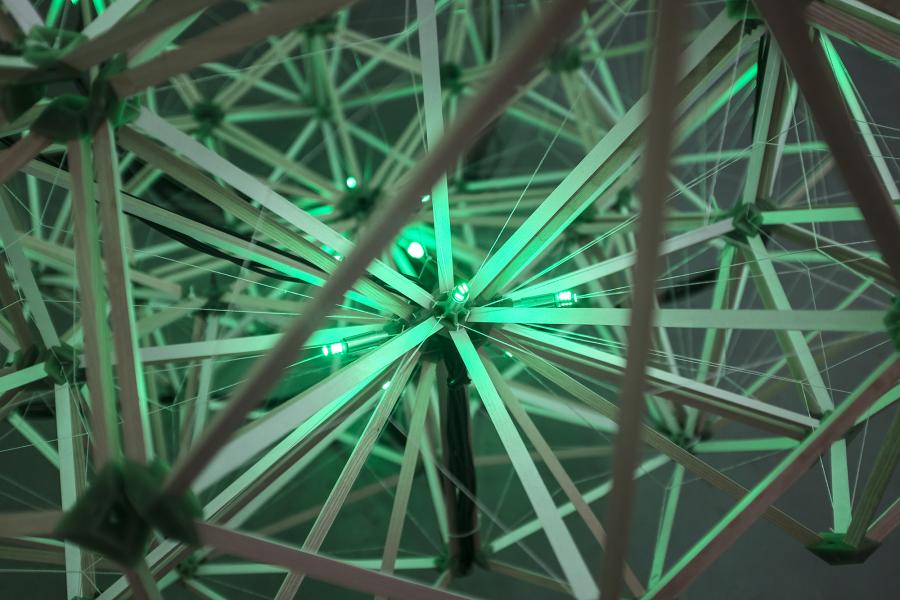
Venice never loses its magic. A subtle festive feeling is always in the air wherever you go. And well, it’s this time of the year again: you can dive into the festival of art, surrounded by amazing architecture in a labyrinth of narrow streets. This state of constantly present beauty, the refreshing breeze from the Lagoon and slightly shaky feeling you get on a pier (caused by bypassing boats or the sparkling prosecco in your hand?) – Venice is always an adventure. Pair it with the opening weekend of Biennale, and it begins to feel like you’re going to a fancy party you’ve been looking forward to for so long. And though spirits are high, this time you suddenly realise: the party is boring, the guests are dull, and you already know that you’ll leave before midnight. Apart from a handful of interesting positions, this year’s Art Biennale seems to be exactly that.
Main Pavilion

Taus Makhacheval
The main exhibition titled "Viva Arte Viva!“ was conceived to put the artist and the artistic practice forward as the only realm in our turbulent and outrageous times where you can express yourself freely and dare to question and criticise the brave new crazy world. “Today, in a world full of conflicts and shocks … art is the ultimate ground for reflection, individual expression, freedom, and for fundamental questions,” declares Christine Macel, the curator of 2017’s International Art Exhibition. She gives the featured artists a carte blanche to demonstrate what it means to make art and be an artist. Well, this might not be the newest approach, but why not do it again! The main pavilion is divided into the "Pavilion of Artists and Books“ and "Pavilion of Joys and Fears“. In the first one we encounter artists contemplating on their own states and practices: sleeping, leading a nomadic life due to unaffordable rents, or meticulously reciting the ways to create an artwork.
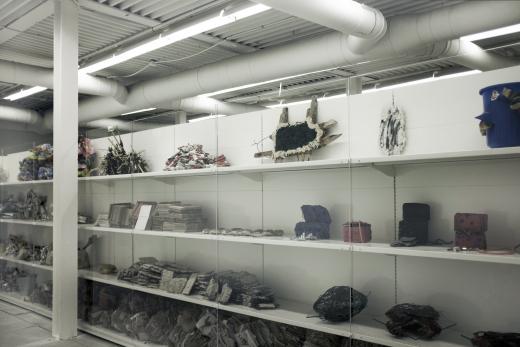
Hassan Sharif
Hassan Sharif exposes all his artworks in a supermarket-like arrangement. The room-filling installation animates a voyeuristic gaze and delivers a commentary on the dissonance between the creative process and commercial machinery of the art market. A wonderfully hypnotic video by Taus Makhacheval reflects on the unstable situation of culture in the Caucasus region. It shows a performance where an acrobat is carrying artworks between two peaks, balancing on a tightrope. The 61 paintings are reproductions from the Dagestan Museum of Fine Art. In the other part of the pavilion the topic seems to be: name as many things you can do with books but reading. Still there are some compelling interpretations, such as the series of works by Ciprian Muresan, who redraws all the reproductions from the catalogues of Tretyakov Gallery in his signature meticulous and well-skilled manner. The pictures and fragments are drawn over each other in multiple layers and create a myriad of recognizable and still alienated images.
Arsenale
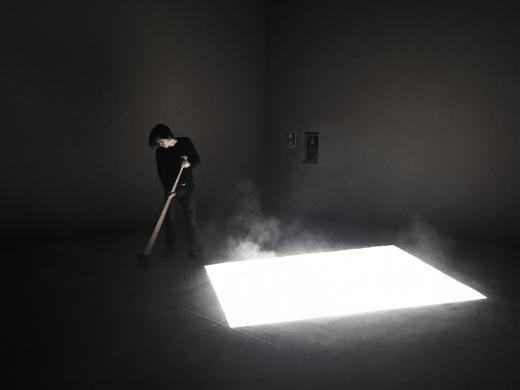
Edith Dekyndt
The exhibition continues at the Arsenale. Here the atmosphere oscillates between DYI-courses, ritual dance join-in activities, and a visit to a local anthropology museum. The oversupply of textile-based works is striking. In contrast to the rugs on the wall, fabrics deconstructed into the thread spools, and an extremely multi-coloured installation of plush globes that cover an entire wall, the only interesting carpet is the carpet of dust. In Edith Dekyndt’s performance, a man swipes dust to a perfectly shaped rectangular that is torn out of the darkness of the room by a bright spotlight.
Among all the possible ways to use fabrics in art, one is happy to see Franz Erhard Walther (the winner of the Golden Lion of the main show) who adds a little more concept to all the wool and shows an approach which remains in the best tradition of conceptual sculpture and still appears to be unconventional and rather refreshing. Never mind that the man is his late 70s - what is good, stays good.
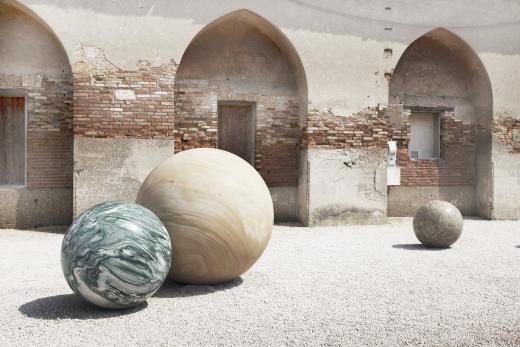
Alicja Kwade
This observation might indeed be the motto of the Arsenale exhibition, since you begin to see the good things much better in contrast, which is rather obvious this time. Jeremy Shaw’s series of photographs capture people in a state of religious trance. The accompanying film „Liminals“ is a fictive science-fiction documentary telling a story of a cult attempting to maintain the human ability of a religious belief. In Kader Attia’s installation, „Narrative Vibrations“, we encounter the voices of great Arab singers. The sounds are translated into electromagnetic impulses that make the grains of couscous, placed on trays, move and produce various, perfectly geometrically arranged patterns. Finally, at the very end of the exhibition, you get lost in the labyrinth of steel bars and mirrors of Alicja Kwade’s installation – it makes you feel like home.
Giardini

Dirk Braeckman @ Belgian pavilion
A stroll through Giardini gives a whiff of fresh air. Here National pavilions are juggling with the topics of identity, movement and migration, history and utopias. Right at the start you can rest your eyes on the wonderfully compelling and hypnotic photographs by Dirk Braeckman in the Belgian pavilion. The idea of a self-image is best interpreted in the Finnish contribution by Nathaniel Mellors and Erkka Nissen. Israel’s Gal Weinstein reflects on human desire to stop time and shows a post-apocalyptic environment, with mouldy floor and walls and a huge space-filling cloud-like object made of felt. Kristine Ropstorff undertakes an intervention to the Danish pavilion and transforms it into a wild garden, whereas Canada’s Geoffrey Farmer turns the pavilion (almost) into a ruin and installs a fountain in the middle of it to reflect on destruction and tragedy, both personal and public.

Gal Weinstein @ Israeli pavilion
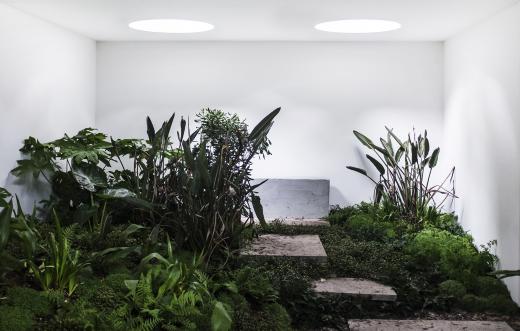
Kristine Ropstorff @ Danish pavilion

Geoffrey Farmer @ Canadian pavilion
The German pavilion certainly steals the show. The performance by Anne Imhof, the winner of the Golden Lion, is strong, penetrating, and moving. The pavilion, curated by Susanne Pfeffer, opens a transparent and yet excluding space covered with glass – walls, pedestals, barriers, lifted floor. The performance, which lasts four to five hours, is a string of physically engaging actions that range from a meditative or nonchalant self-absorption to a violent interaction of bodies. It shows the body as an object to capitalistic exploitation and explores historical and contemporary concepts of power and control. The piece is a powerful reflection on the body, its abilities and boundaries, self-awareness and self-questioning.

Anne Imhof @ German pavilion
Even though the general feeling is that of a competition in mediocrity, there are still some interesting insights and discoveries that make this Biennale worth your while. If you manage to ignore the lack of critical curatorial statements that killed the party, you might actually have some fun.
* * * * *
Text: Oksana Shestaka / Photos: Alexandra Polyakova
La Biennale di Venezia - 57th International Art Exhibition
May 13 – November 26, 2017
More info